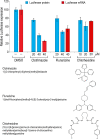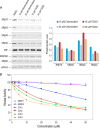Rapid-response splicing reporter screens identify differential regulators of constitutive and alternative splicing
- PMID: 20123975
- PMCID: PMC2838070
- DOI: 10.1128/MCB.01301-09
Rapid-response splicing reporter screens identify differential regulators of constitutive and alternative splicing
Abstract
Bioactive compounds have been invaluable for dissecting the mechanisms, regulation, and functions of cellular processes. However, very few such reagents have been described for pre-mRNA splicing. To facilitate their systematic discovery, we developed a high-throughput cell-based assay that measures pre-mRNA splicing by utilizing a quantitative reporter system with advantageous features. The reporter, consisting of a destabilized, intron-containing luciferase expressed from a short-lived mRNA, allows rapid screens (<4 h), thereby obviating the potential toxicity of splicing inhibitors. We describe three inhibitors (out of >23,000 screened), all pharmacologically active: clotrimazole, flunarizine, and chlorhexidine. Interestingly, none was a general splicing inhibitor. Rather, each caused distinct splicing changes of numerous genes. We further discovered the target of action of chlorhexidine and show that it is a selective inhibitor of specific Cdc2-like kinases (Clks) that phosphorylate serine-arginine-rich (SR) protein splicing factors. Our findings reveal unexpected activities of clinically used drugs in splicing and uncover differential regulation of constitutively spliced introns.
Figures







Similar articles
-
Conserved proline-directed phosphorylation regulates SR protein conformation and splicing function.Biochem J. 2015 Mar 1;466(2):311-22. doi: 10.1042/BJ20141373. Biochem J. 2015. PMID: 25529026 Free PMC article.
-
CLK-dependent exon recognition and conjoined gene formation revealed with a novel small molecule inhibitor.Nat Commun. 2017 Feb 23;8(1):7. doi: 10.1038/s41467-016-0008-7. Nat Commun. 2017. PMID: 28232751 Free PMC article.
-
Manipulation of alternative splicing by a newly developed inhibitor of Clks.J Biol Chem. 2004 Jun 4;279(23):24246-54. doi: 10.1074/jbc.M314298200. Epub 2004 Mar 8. J Biol Chem. 2004. PMID: 15010457
-
SR protein kinases: the splice of life.Biochem Cell Biol. 1999;77(4):293-8. Biochem Cell Biol. 1999. PMID: 10546892 Review.
-
Human CDC2-like kinase 1 (CLK1): a novel target for Alzheimer's disease.Curr Drug Targets. 2014 May;15(5):539-50. doi: 10.2174/1389450115666140226112321. Curr Drug Targets. 2014. PMID: 24568585 Review.
Cited by
-
The spliceosome as a target of novel antitumour drugs.Nat Rev Drug Discov. 2012 Nov;11(11):847-59. doi: 10.1038/nrd3823. Nat Rev Drug Discov. 2012. PMID: 23123942 Review.
-
Nuclear speckle specific hnRNP D-like prevents age- and AD-related cognitive decline by modulating RNA splicing.Mol Neurodegener. 2021 Sep 22;16(1):66. doi: 10.1186/s13024-021-00485-w. Mol Neurodegener. 2021. PMID: 34551807 Free PMC article.
-
Nutrient control of splice site selection contributes to methionine addiction of cancer.Mol Metab. 2025 Mar;93:102103. doi: 10.1016/j.molmet.2025.102103. Epub 2025 Jan 23. Mol Metab. 2025. PMID: 39862967 Free PMC article.
-
Design of a GFP reporter for splicing analysis in mammalian cells.Biotechnol Rep (Amst). 2025 Mar 13;46:e00887. doi: 10.1016/j.btre.2025.e00887. eCollection 2025 Jun. Biotechnol Rep (Amst). 2025. PMID: 40212027 Free PMC article.
-
Aberrant splicing exonizes C9orf72 repeat expansion in ALS/FTD.Nat Neurosci. 2025 Aug 11. doi: 10.1038/s41593-025-02039-5. Online ahead of print. Nat Neurosci. 2025. PMID: 40790269
References
-
- Alvarez, J., M. Montero, and J. Garcia-Sancho. 1992. High affinity inhibition of Ca(2+)-dependent K+ channels by cytochrome P-450 inhibitors. J. Biol. Chem. 267:11789-11793. - PubMed
-
- Benzaquen, L. R., C. Brugnara, H. R. Byers, S. Gatton-Celli, and J. A. Halperin. 1995. Clotrimazole inhibits cell proliferation in vitro and in vivo. Nat. Med. 1:534-540. - PubMed
-
- Black, D. L. 2003. Mechanisms of alternative pre-messenger RNA splicing. Annu. Rev. Biochem. 72:291-336. - PubMed
Publication types
MeSH terms
Substances
Grants and funding
LinkOut - more resources
Full Text Sources
Other Literature Sources
Molecular Biology Databases
Research Materials
Miscellaneous
